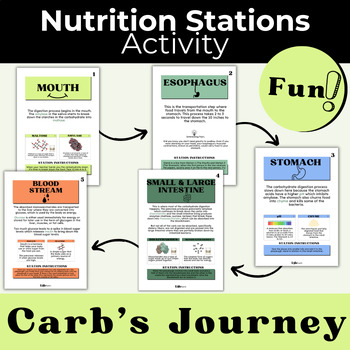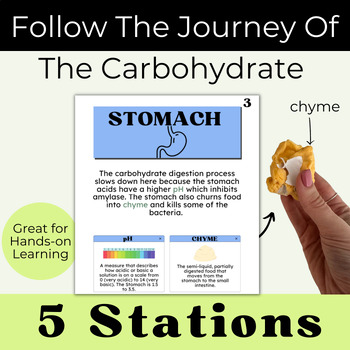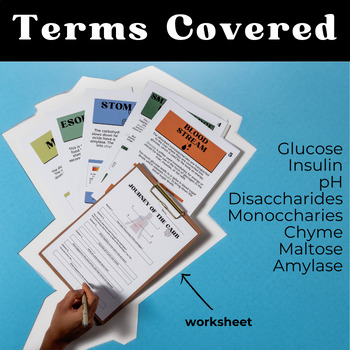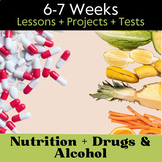The Journey of a Carbohydrate: High School Health Simulation/Station Activity
- PDF
What educators are saying
Also included in
- High School Nutrition Unit - 1 Month of Comprehensive Learning! After years of fine-tuning and gathering feedback, I am stoked to present the best unit I've ever made! This resource isn't just another nutrition unit; it's nutrition's latest and best research made into 3-4 weeks of fun student-cenPrice $39.00Original Price $56.60Save $17.60
- Unlock a transformative learning experience with this 6-7 week Health and Wellness Bundle designed for grades 9-12! This bundle combines two robust units—Addiction Awareness and Comprehensive Nutrition—into a single, powerhouse curriculum. By merging essential topics like addiction dangers, drugs, aPrice $80.00Original Price $98.18Save $18.18
- If you're on the lookout for a health curriculum that ACTUALLY RESONATES with high schoolers, I've got you! This SEMESTER LONG bundle tackles everything from nutrition to mental health, healthy relationships, social-emotional learning, and the real-talk on drugs and alcohol awareness. Each of the lPrice $150.00Original Price $195.97Save $45.97
Description
Get ready to unravel the process of carbohydrate digestion with this hands-on activity! Most digestion lessons are a bit boring, but this one will get your students out if their chairs and seeing how amazing our bodies actually are at making energy from food.
Your students will journey through 5 stations, each representing a different stage of carbohydrate digestion (mouth, esophogus, stomach, intestines, bloodstream). They are given a carbohydrate and watch it transform through the stages of digestion, gaining insights about the roles of different enzymes, the effects of pH, and the importance of glucose.
Each round adds a new layer of understanding, revealing the details of our digestive system, including what happens when there's too much glucose in the body. With this activity (and the accompanying worksheet), students will grasp the complexity of carbohydrate digestion and reflect on how the body turns food into energy.
Included:
- Detailed teacher instructions
- Worksheets to track the journey
- Station instructions with pictures
- Printable labels for props
Materials needed: This activity does require some preparation
- Playdough or slime (Chyme)
- 3 Containers (representing the "Intestines" "Bloodstream, and Fat Cells")
- Printed worksheet
- Printed station instructions
This activity takes up a 45-60 min lesson. Ideal for upper middle school and high school students! Suitable for grades 7-12!
⭐ Need other lessons to go along with your nutrition unit?? ⭐
History's Weirdest Diets - Dangers of Fad Diets
Nutrition Labels Scavenger Hunt
High School Nutrition 101: Google Slides
Nutrition Voyage- Food Selection Simulation
Nutritional Guidelines: MyPlate
Meal Match: Nutrition Uno Game
OR
Like these kinds of resources? Check out my FULL SEMESTER HEALTH BUNDLE!
__________________________________________________________________
⭐ Follow me for more classroom favorites!
If you’re into the gram @_lifefluent
✉️ Feedback or fist bumps? I’m here: lifefluentclassroom@gmail.com
Sign up for my news bites and get one of my best resources – my treat!
________________________________________________________________
Leave a Review!
Did you know you can receive credit for your next TpT product by reviewing old ones??
If you like this product, please leave a review on the product page or through “My Purchases” under “My Account”. Thank you <3








